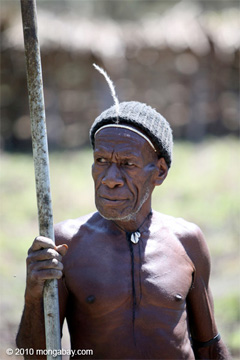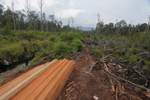Involving local communities in the governance of forest resources boosts economic returns and biodiversity relative to areas where locals have little participation, report researchers writing in Science. The findings have implications for efforts to protect and sustainably manage forests under the reducing emissions from deforestation and degradation (REDD) mechanism.
Analyzing data from 84 villages across Kenya, Tanzania, Uganda, India, Nepal and Bhutan, Lauren Persha of the University of Michigan and colleagues found that livelihoods of forest-dependent communities and forest biodiversity were higher when local populations are directly participate in rule-making aspects of forest governance.

|
“There has been a lot of rhetoric around achieving ‘win-win’ outcomes across social and ecological dimensions of forests, while some think win-wins are impossible and trade-offs are inevitable,” said Persha, a postdoctoral research fellow with the International Forestry Resources and Institutions (IFRI) Research Program, in a statement. “But, there has been very little work to date which uses systematic and sufficiently robust data to try to move beyond this ‘either/or’ rhetoric in order to better understand relationships between social and ecological outcomes from forests, or to identify important institutional, socio-economic, policy, or related factors that are associated which jointly positive outcomes.”
“Rulemaking participation rights for local forest users was a key factor in getting a win-win situation in our research,” added co-author Arun Agrawal, also with the University of Michigan and IFRI. “Similarly, we found a greater likelihood of a forest being below average for both subsistence livelihoods and biodiversity when local forest users do not have this right.”
The findings lend support to the argument that local communities should have a say in whether they participate in REDD, a climate change mitigation strategy that proposes paying tropical countries for protecting and sustainably managing forests. REDD advocates say the mechanism could help safeguard biodiversity and generate income for local communities, but REDD has faced stiff opposition from local populations who want to determine on their own how they will manage forest resources they traditionally use.
Lauren Persha, Arun Agrawal, Ashwini Chhatre. Social and Ecological Synergy: Local Rulemaking, Forest Livelihoods, and Biodiversity Conservation. 25 MARCH 2011 VOL 331 SCIENCE
Related articles
Fighting illegal logging in Indonesia by giving communities a stake in forest management

(03/10/2011) Over the past twenty years Indonesia lost more than 24 million hectares of forest, an area larger than the U.K. Much of the deforestation was driven by logging for overseas markets. According to the World Bank, a substantial proportion of this logging was illegal. Curtailing illegal logging may seem relatively simple, but at the root of the problem of illegal logging is something bigger: Indonesia’s land policy. Can the tide be turned? There are signs it can. Indonesia is beginning to see a shift back toward traditional models of forest management in some areas. Where it is happening, forests are recovering. Telapak understands the issue well. It is pushing community logging as the ‘new’ forest management regime in Indonesia. Telapak sees community forest management as a way to combat illegal logging while creating sustainable livelihoods.
Communities must benefit for forest carbon schemes to be effective
(12/13/2007) Much has been promised by what avoided deforestation (AD) carbon credits can do to support forest protection, increase tax revenues, and develop sustainable rural economies in our Zamrud Khatulistiwa — Emerald on the Equator. In the wake up of the COP 13 meeting in Bali, the focus of media attention has been on how much money rainforest countries can receive for protecting their forests.
Communities must benefit for forest carbon schemes to be effective
Much has been promised by what avoided deforestation (AD) carbon credits can do to support forest protection, increase tax revenues, and develop sustainable rural economies in our Zamrud Khatulistiwa — Emerald on the Equator. In the wake up of the COP 13 meeting in Bali, the focus of media attention has been on how much money rainforest countries can receive for protecting their forests.